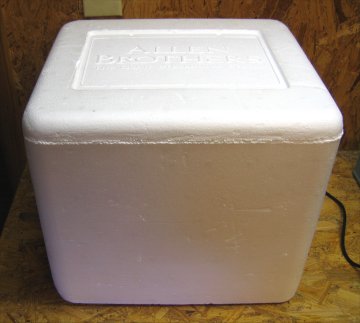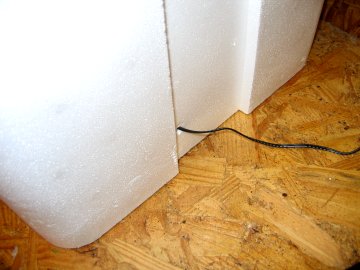

|
<<< Continued from previous page Second, an enclosure. This is one occasion when a cardboard box won't do because the idea is to keep the ozone confined so as to be both available to do its thing and to stay the heck out of your lungs. Small amounts of ozone pose little or no threat to your health; larger amounts, however, may damage your lungs. My rule of thumb is, if I can smell it, it's too much. My enclosure is a Styrofoam cooler that once transported some overpriced steaks:

It's deep enough to accommodate tall books stood vertically (more about this later), and the lid fits snugly enough to keep the ozone in. I punched a hole big enough to feed the plug into it on the side, then plugged it with some plumber's putty.

You could also use a plastic bin with a snap-on lid, but I'd be less comfortable with this nearby unless the lid could be modified, perhaps with adhesive foam insulation, to fit more tightly. Books pose a special problem for odor treatment because they are at once porous enough to absorb odors into every last page but not quick to give them up, given that the pages are in such close contact to each other. Standing books up in the generator housing with pages fanned open is essential, of course, but it's impossible to fan all of them or even most of them open. Here's what I do to make sure everything gets zapped quickly:

Cable ties can be inserted between pages in a matter of minutes, sometimes moments, and are thick enough to keep the pages separated but not so thick as to be unworkable. They can be purchased in bulk in numerous sizes at any home improvement center and will last indefinitely. I use 14" ties on everything, even books taller than 14". So - how fast can a book be treated? If it's simply an odor issue, sometimes in a matter of hours, sometimes overnight or in a day or two. A lot depends on the porosity of the paper and how many pages are involved. A few books will require longer treatments, especially if mold or mildew is present. Generally, you can safely acquire a problem book, list it immediately, and have it ready to ship in an odor-free state should it sell quickly. A few small cautions. There are, apparently, a few fabrics and papers that can be adversely affected by ozone, also some dyes used to color them. The risk seems small overall - I've yet to have an issue - but it's there nonetheless. Finally, a GIANT caution. If you're going to zap books with mildew, yes, it can be entirely eliminated, theoretically, but if you don't get it all - and how will you know if you do? - where are you? At an ethical crossroad. A small number of remaining active spores (which would be difficult to detect by smelling) could eventually propagate into a big problem. If the book travels to another library, it could spread the problem to other books. It's one thing if you're risking a book you plan to keep, quite another if you're selling it.
Want to read more articles by
< to previous article
to next article >
Questions or comments?
| Forum
| Store
| Publications
| BookLinks
| BookSearch
| BookTopics
| Archives
| Advertise
| AboutUs
| ContactUs
| Search Site
| Site Map
| Google Site Map
Store - Specials
| BookHunt
| BookShelf
| Gold Edition & BookThink's Quarterly Market Report
| DomainsForSale
| BookThinker newsletter - free
Copyright 2003-2011 by BookThink LLC
|

|
|